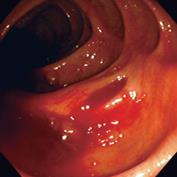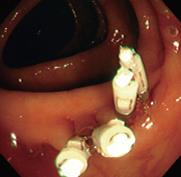Published online Aug 14, 2009. doi: 10.3748/wjg.15.3817
Revised: July 15, 2009
Accepted: July 22, 2009
Published online: August 14, 2009
We herein report the rare complication of sepsis caused by endoscopic clipping for colonic diverticular bleeding. A 78-year-old man with a 12-h history of near syncope and painless hematochezia was admitted to our hospital. Following the transfusion of 4 U of blood and continued hematochezia, a colonoscopy was performed. Active bleeding was seen as continuous arterial spurting from a single diverticulum located in the middle ascending colon. This diverticulum was seamed by four endoclips. The next day, the patient became febrile with a temperature of 39.2°C. Laboratory data included a white blood cell count of 18 100/mm3 and a C-reactive protein level of 3.4 mg/dL. He was diagnosed with sepsis since Escherichia coli was detected in the blood culture. Antibiotics were started. Four days later his fever had improved and laboratory data improved 9 d later.
- Citation: Kume K, Yamasaki M, Yoshikawa I. Sepsis caused by endoscopic clipping for colonic diverticular bleeding: A rare complication. World J Gastroenterol 2009; 15(30): 3817-3818
- URL: https://www.wjgnet.com/1007-9327/full/v15/i30/3817.htm
- DOI: https://dx.doi.org/10.3748/wjg.15.3817
Diverticular bleeding is one of the most common causes of lower-GI bleeding. It has been reported that endoscopic clipping is effective in diverticular bleeding[1–3]. However, we wish to report the rare complication of sepsis caused by endoscopic clipping for colonic diverticular bleeding.
A 78-year-old man with a 12-h history of near syncope and painless hematochezia was admitted to our hospital. On admission his blood pressure was 76/40 mmHg and his pulse was 87 beats per minute. Hemoglobin level was 8.6 g/dL. Following the transfusion of 4 U of blood and continued hematochezia, a colonoscopy was performed. The examination was completed to the cecum. Severe diverticulosis was present from the sigmoid colon to the ascending colon, and active bleeding was seen as continuous arterial spurting from a single diverticulum located in the middle ascending colon (Figure 1). This diverticulum was seamed by 4 endoclips (Figure 2).
The next day, the patient became febrile with a temperature of 39.2°C. Laboratory data included a white blood cell count of 18 100/mm3 and a C-reactive protein level of 3.4 mg/dL. He was diagnosed with sepsis since Escherichia coli (E. coli) was detected in the blood culture. Antibiotics were started. Four days later his fever improved and his laboratory data improved 9 d later.
Although diverticular bleeding episodes are often self-limiting, massive hemorrhage requiring therapeutic intervention occurs in a significant number of patients. Endoscopic clipping and other endoscopic therapies have been the treatment of choice in such cases[1–4].
Normally, hemoclips are placed on and around the visible vessel and immediate hemostasis is completed[1–4]. However, we seamed the diverticulum itself using endoclips because of difficulty in recognizing the visible vessel due to massive arterial spurting. The next day, the patient developed sepsis. This was probably because E. coli was present in the diverticulum which then invaded blood vessels.
It is important that hemoclips are placed on and around the visible vessel if possible, because it can alert the endoscopist to be mindful of potential hazards such as the one we encountered. However, hemoclips would appear to pose a risk of perforation when applied to the thin dome of a diverticulum.
| 1. | Simpson PW, Nguyen MH, Lim JK, Soetikno RM. Use of endoclips in the treatment of massive colonic diverticular bleeding. Gastrointest Endosc. 2004;59:433-437. |
| 2. | Rino Y, Imada T, Iwasaki H, Tanabe H, Toyoda H, Kato N, Amano T, Kondo J. Hemostasis of colonic diverticular bleeding with hemoclips under endoscopic control: report of a case. Hepatogastroenterology. 1999;46:1733-1735. |
| 3. | Hokama A, Uehara T, Nakayoshi T, Uezu Y, Tokuyama K, Kinjo F, Saito A. Utility of endoscopic hemoclipping for colonic diverticular bleeding. Am J Gastroenterol. 1997;92:543-546. |
| 4. | Jensen DM, Machicado GA, Jutabha R, Kovacs TO. Urgent colonoscopy for the diagnosis and treatment of severe diverticular hemorrhage. N Engl J Med. 2000;342:78-82. |










